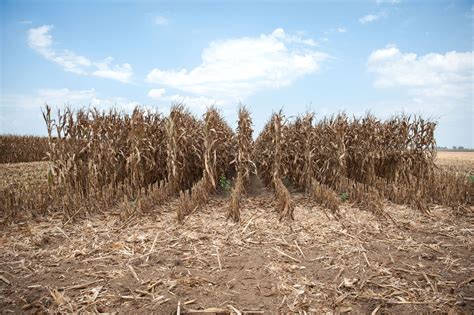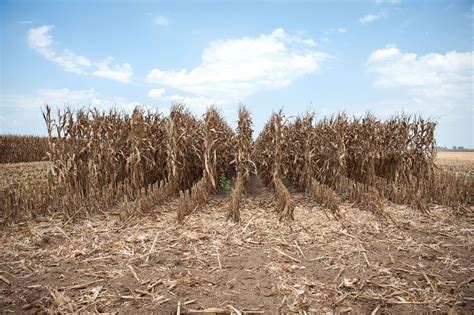
Farmers in several regions are reeling from catastrophic crop losses, with some reporting as much as 90% devastation, marking what many are calling the worst agricultural disaster in decades due to an unprecedented weather event.
The agricultural community is facing widespread devastation after a sudden and intense weather phenomenon decimated crops across several states. Farmers are reporting losses ranging from significant setbacks to near-total wipeouts, with some estimating as much as 90% of their yields destroyed. This unprecedented event is poised to have far-reaching consequences, impacting food supplies, commodity prices, and the livelihoods of countless agricultural families.
“It’s a complete disaster,” said one farmer from Illinois, whose corn and soybean fields were ravaged. “I’ve never seen anything like this in my lifetime. We’re talking about losing everything we’ve worked for.” Similar sentiments are echoing across the Midwest and other affected regions, as farmers grapple with the scale of the devastation. The specific nature of the weather event varies depending on the location, ranging from torrential rains and flooding to sudden frosts and hailstorms, but the end result is the same: widespread crop failure.
The immediate impact is on the farmers themselves, many of whom are facing financial ruin. Without a harvest to sell, they are unable to pay back loans, cover operating expenses, or provide for their families. The long-term consequences could be even more severe. Reduced crop yields will likely lead to higher food prices for consumers, impacting household budgets and potentially exacerbating food insecurity, especially among vulnerable populations. The ripple effects could also extend to related industries, such as food processing, transportation, and agricultural supply companies.
Agricultural experts are scrambling to assess the full extent of the damage and determine the best course of action. Government agencies are being urged to provide emergency assistance to farmers, including financial aid, crop insurance payouts, and disaster relief programs. However, some farmers worry that this assistance will not be enough to offset their losses, especially for those who were already struggling financially before the disaster struck. The event raises serious questions about the resilience of the agricultural system in the face of increasingly extreme weather events. Climate change is widely believed to be a contributing factor, and experts warn that similar disasters could become more frequent and severe in the future.
The losses are not confined to a single type of crop. Corn, soybeans, wheat, fruits, and vegetables have all been affected, indicating the widespread nature of the disaster. This diversity of impacted crops increases the potential for widespread food supply chain disruptions and price increases. The scale of the crisis is prompting calls for a comprehensive review of agricultural policies and practices to better protect farmers and ensure food security. This includes investing in research and development of drought-resistant and flood-tolerant crops, improving water management infrastructure, and strengthening crop insurance programs.
One agricultural economist noted, “This event serves as a stark reminder of the vulnerability of our food system. We need to take proactive steps to mitigate the risks posed by climate change and other factors that can disrupt agricultural production.” The current situation highlights the urgent need for a multi-faceted approach that addresses both the immediate crisis and the long-term challenges facing the agricultural sector. This includes providing immediate relief to struggling farmers, investing in sustainable agricultural practices, and developing strategies to adapt to a changing climate.
The disaster also underscores the importance of crop insurance as a safety net for farmers. However, many farmers have expressed concerns about the adequacy of existing crop insurance programs, citing issues such as high premiums, limited coverage, and bureaucratic delays in processing claims. There are calls for reforms to crop insurance programs to make them more accessible, affordable, and responsive to the needs of farmers in times of crisis.
The long-term implications of this crop apocalypse are yet to be fully understood. However, it is clear that the agricultural sector faces significant challenges in the years to come. The ability of farmers, policymakers, and researchers to work together to address these challenges will be critical to ensuring food security and the long-term viability of the agricultural industry. This crisis demands immediate action and long-term planning to safeguard the future of farming and food production. The impact extends beyond the fields; it touches the entire economy and the well-being of communities that rely on agriculture.
The Devastating Details
The reports coming in from the affected areas paint a grim picture. In some regions, entire fields have been completely wiped out, leaving behind nothing but mud and debris. In others, crops have been severely damaged, rendering them unsalable or significantly reducing their yield. The specific causes of the damage vary, but they all share a common thread: extreme weather.
- Flooding: Torrential rains have caused widespread flooding in many areas, inundating fields and drowning crops. The excess water has also led to soil erosion and nutrient loss, further damaging the land.
- Frost: Unseasonably cold temperatures have resulted in frost damage, particularly to fruit trees and other sensitive crops. The frost has killed buds and blossoms, preventing the plants from producing fruit.
- Hail: Severe hailstorms have battered crops, shredding leaves, breaking stems, and damaging fruits and vegetables. The hail has also left plants vulnerable to disease and insect infestations.
- Drought: In other regions, prolonged drought conditions have withered crops and stunted their growth. The lack of rainfall has stressed plants, making them more susceptible to pests and diseases.
The cumulative effect of these extreme weather events has been devastating. Farmers who had invested their time, money, and labor into planting and cultivating their crops are now facing the prospect of losing everything. The emotional toll is immense, as they watch their livelihoods being destroyed by forces beyond their control.
The Economic Ripple Effect
The crop losses are not just a problem for farmers; they have significant implications for the entire economy. Agriculture is a major industry in many states, and a decline in agricultural production can have a ripple effect throughout the economy.
- Food Prices: Reduced crop yields will likely lead to higher food prices for consumers. This is because the supply of food will be reduced, while demand remains the same. Higher food prices can strain household budgets, particularly for low-income families.
- Job Losses: The agricultural sector employs millions of people, both directly and indirectly. Crop losses can lead to job losses in farming, food processing, transportation, and other related industries.
- Reduced Exports: The United States is a major exporter of agricultural products. Crop losses can reduce the volume of exports, which can negatively impact the trade balance.
- Impact on Related Industries: The agricultural sector supports a wide range of related industries, such as agricultural supply companies, equipment manufacturers, and financial institutions. Crop losses can negatively impact these industries as well.
The economic consequences of the crop apocalypse could be felt for years to come. It is essential that policymakers take action to mitigate the damage and support the agricultural sector during this difficult time.
The Role of Climate Change
While it is impossible to attribute any single weather event solely to climate change, scientists warn that climate change is increasing the frequency and intensity of extreme weather events. Rising temperatures, changing precipitation patterns, and increased atmospheric instability are all contributing to more frequent and severe droughts, floods, heatwaves, and storms.
“Climate change is already having a significant impact on agriculture,” said one climate scientist. “We are seeing more frequent and intense extreme weather events, which are disrupting crop production and threatening food security.”
Addressing climate change is essential to protecting the agricultural sector from future disasters. This includes reducing greenhouse gas emissions, investing in renewable energy, and developing climate-resilient agricultural practices.
Potential Solutions and Mitigation Strategies
Addressing the “crop apocalypse” requires a multifaceted approach that combines immediate relief measures with long-term strategies for building resilience and adapting to changing climate conditions. Here’s a breakdown of potential solutions:
-
Immediate Financial Assistance: The most pressing need is to provide immediate financial assistance to farmers who have suffered significant crop losses. This could take the form of direct payments, low-interest loans, and grants to help farmers cover their operating expenses and avoid bankruptcy. Streamlining the application process for these programs is crucial to ensure that aid reaches farmers quickly.
-
Crop Insurance Reform: While crop insurance is intended to provide a safety net, many farmers find the current system inadequate. Reforms should focus on lowering premiums, increasing coverage levels, and simplifying the claims process. Consideration should be given to developing new insurance products that are better tailored to the specific risks faced by farmers in different regions.
-
Disaster Relief Programs: Government agencies should expand and strengthen disaster relief programs to provide assistance to farmers affected by extreme weather events. These programs should include provisions for crop loss compensation, soil restoration, and infrastructure repair.
-
Investment in Research and Development: Investing in research and development of drought-resistant, flood-tolerant, and disease-resistant crop varieties is essential for building resilience in the face of climate change. This research should focus on developing crops that can withstand extreme weather conditions and maintain high yields.
-
Improved Water Management: Water is a critical resource for agriculture, and improved water management practices are essential for mitigating the impacts of drought and flooding. This includes investing in irrigation infrastructure, promoting water conservation techniques, and developing strategies for managing water resources during periods of scarcity.
-
Soil Health Practices: Healthy soil is more resilient to extreme weather conditions. Promoting soil health practices such as no-till farming, cover cropping, and crop rotation can improve soil structure, water infiltration, and nutrient retention, making crops more resistant to drought and flooding.
-
Diversification of Crops: Encouraging farmers to diversify their crops can reduce their vulnerability to weather-related risks. By planting a variety of crops, farmers can spread their risk and reduce the likelihood of experiencing total crop failure.
-
Early Warning Systems: Developing and implementing early warning systems for extreme weather events can give farmers time to prepare and take steps to protect their crops. These systems should provide timely and accurate information about impending droughts, floods, and storms.
-
Infrastructure Improvements: Investing in infrastructure improvements, such as drainage systems, flood control measures, and transportation networks, can help to mitigate the impacts of extreme weather events on agriculture.
-
Climate Change Mitigation: Addressing climate change is essential for protecting the agricultural sector from future disasters. This includes reducing greenhouse gas emissions, investing in renewable energy, and promoting sustainable agricultural practices that reduce carbon emissions and sequester carbon in the soil.
-
Community Support and Mental Health Services: The stress and financial hardship associated with crop losses can have a significant impact on farmers’ mental health. Providing access to community support and mental health services is essential for helping farmers cope with the emotional toll of these events.
-
Policy and Regulatory Changes: Policymakers need to enact policies and regulations that support sustainable agriculture, promote climate resilience, and protect farmers from the risks associated with extreme weather events. This includes providing incentives for adopting sustainable agricultural practices, regulating greenhouse gas emissions, and strengthening crop insurance programs.
By implementing these solutions, it is possible to mitigate the impacts of the crop apocalypse, build resilience in the agricultural sector, and ensure food security for future generations. The key is to take a proactive and comprehensive approach that addresses both the immediate crisis and the long-term challenges facing agriculture.
Frequently Asked Questions (FAQ)
-
What caused the widespread crop losses being reported?
The crop losses are attributed to a combination of extreme weather events across different regions. These include torrential rains and flooding, unseasonable frost, severe hailstorms, and prolonged drought. The specific cause varies by location, but the common thread is extreme weather devastating crops.
-
Which crops are most affected by this disaster?
A wide variety of crops have been affected, including staple crops such as corn, soybeans, and wheat, as well as fruits and vegetables. This widespread impact indicates potential disruptions in the broader food supply chain.
-
What kind of financial assistance is available to farmers who have suffered losses?
Financial assistance options include direct payments from government agencies, low-interest loans to cover operating expenses, and grants for recovery efforts. Crop insurance payouts are also a critical source of support for those who have policies. However, the adequacy of crop insurance is a concern for many.
-
How will these crop losses affect food prices for consumers?
Reduced crop yields are likely to lead to higher food prices for consumers. A decreased supply of agricultural products, with steady demand, will likely increase the cost of food, affecting household budgets, particularly for low-income families.
-
What is being done to prevent similar crop disasters in the future?
Efforts to prevent future disasters include investing in research and development of climate-resilient crops (drought-resistant and flood-tolerant varieties), improving water management infrastructure, promoting sustainable agricultural practices, and addressing climate change through emissions reductions and adaptation strategies. Strengthening crop insurance programs and disaster relief programs are also critical.
-
What is the potential impact on local and national economies?
The crop losses can have significant ripple effects. Job losses are likely in farming, food processing, transportation, and related industries. Reduced agricultural exports will hurt the trade balance. Businesses that supply the agricultural sector, such as equipment manufacturers and financial institutions, will also suffer.
-
Are there any long-term solutions being considered to help farmers adapt to increasingly extreme weather?
Long-term solutions include diversification of crops, improving soil health through sustainable practices, and the development of early warning systems for extreme weather. The implementation of better infrastructure, such as drainage systems and flood control measures, is also essential. Climate change mitigation efforts are critical to addressing the root causes.
-
What role does crop insurance play in mitigating the financial impact of these losses, and are there any issues with current crop insurance programs?
Crop insurance serves as a safety net, but many farmers find the current system inadequate due to high premiums, limited coverage, and bureaucratic delays. Reforms are needed to make the programs more accessible, affordable, and responsive to farmers’ needs during crises.
-
How can consumers help support farmers during this difficult time?
Consumers can support farmers by buying locally sourced products whenever possible, advocating for policies that support sustainable agriculture, and donating to organizations that provide assistance to farmers in need. Raising awareness about the challenges faced by farmers can also help to generate support for the agricultural community.
-
What resources are available for farmers struggling with mental health issues as a result of these losses?
Community support groups, mental health services, and crisis hotlines are available to help farmers cope with the stress and emotional toll of crop losses. Many agricultural organizations and government agencies offer resources and support for mental health. It is crucial for farmers to seek help when needed and to prioritize their well-being during this challenging time.









